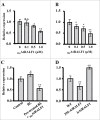Antagonistic relationship between AtRALF1 and brassinosteroid regulates cell expansion-related genes
- PMID: 25482784
- PMCID: PMC4621977
- DOI: 10.4161/15592324.2014.976146
Antagonistic relationship between AtRALF1 and brassinosteroid regulates cell expansion-related genes
Abstract
Rapid alkalinization factor (RALF) is a peptide signal that plays a role in plant cell expansion. We have recently proposed that AtRALF1 negatively regulates root cell elongation and lateral root formation by opposing the effects of brassinosteroid (BR). We reported 6 AtRALF1-inducible cell wall-related genes and 2 P450 monooxygenase -encoding genes involved in the BR biosynthetic pathway. The AtRALF1-inducible genes implicated in cell wall remodeling were not downregulated by brassinolide (BL) treatment alone; their induction was only compromised following simultaneous treatment with AtRALF1 and BL. We further examined the cell wall-remodeling gene EXPANSIN A5 (AtEXPA5), which is upregulated by BL and has been shown to positively affect root cell elongation. Herein, we report that AtEXPA5 expression is downregulated by AtRALF1 in a dose-dependent manner in the roots and hypocotyls of Arabidopsis plants. AtEXPA5 is also downregulated in plants that overexpress AtRALF1, and it is upregulated in plants in which the AtRALF1 gene is partially silenced. The AtRALF1 peptide is also able to repress AtEXPA5 induction following a pre-treatment with BL. A schematic diagram showing the gene regulatory network connecting the recently reported genes with the regulation of cell expansion by AtEXPA5 is presented.
Keywords: Arabidopsis thaliana; brassinolide; cell elongation; expansin; peptide hormone.
Figures


References
-
- Matsubayashi Y, Sakagami Y. Peptide hormones in plants. Annu Rev Plant Biol 2006; 57:649-74; PMID:16669777; http://dx.doi.org/10.1146/annurev.arplant.56.032604.144204 - DOI - PubMed
-
- Moura DS, Silva-Filho MCS. Plant peptide hormones, from defense to pollen self incompatibility, cell fate and development: small peptides as signaling molecules in plants. In: Floriculture, Ornamental and Plant Biotechnology: Advances and Topical Issues (1st Edition), Teixeira da Silva JA. (ed), Global Science Books, London, UK, 2006, pp 1-7
-
- Pearce G, Moura DS, Stratmann J, Ryan CA. RALF, a 5-kDa ubiquitous polypeptide in plants, arrests root growth and development. Proc Natl Acad Sci USA 2001; 98: 12843-7; PMID:11675511; http://dx.doi.org/10.1073/pnas.201416998 - DOI - PMC - PubMed
-
- Guerreiro JR, Pearce G, Silva-Filho MC, Moura DS. RALF peptides. Handbook of Biologically Active Peptides; Kastin AJ (ed.), 2013, pp. 46-49.
-
- Morato do Canto A, Ceciliato PHO, Ribeiro B, Ortiz-Morea FA, Franco Garcia AA, Silva-Filho MC, Moura DS. Biological activity of nine recombinant AtRALF peptides: implications for their perception and function in Arabidopsis. Plant Physiol Biochem 2014; 75:45-54; PMID:24368323; http://dx.doi.org/10.1016/j.plaphy.2013.12.005 - DOI - PubMed
Publication types
MeSH terms
Substances
LinkOut - more resources
Full Text Sources
Other Literature Sources
Molecular Biology Databases
